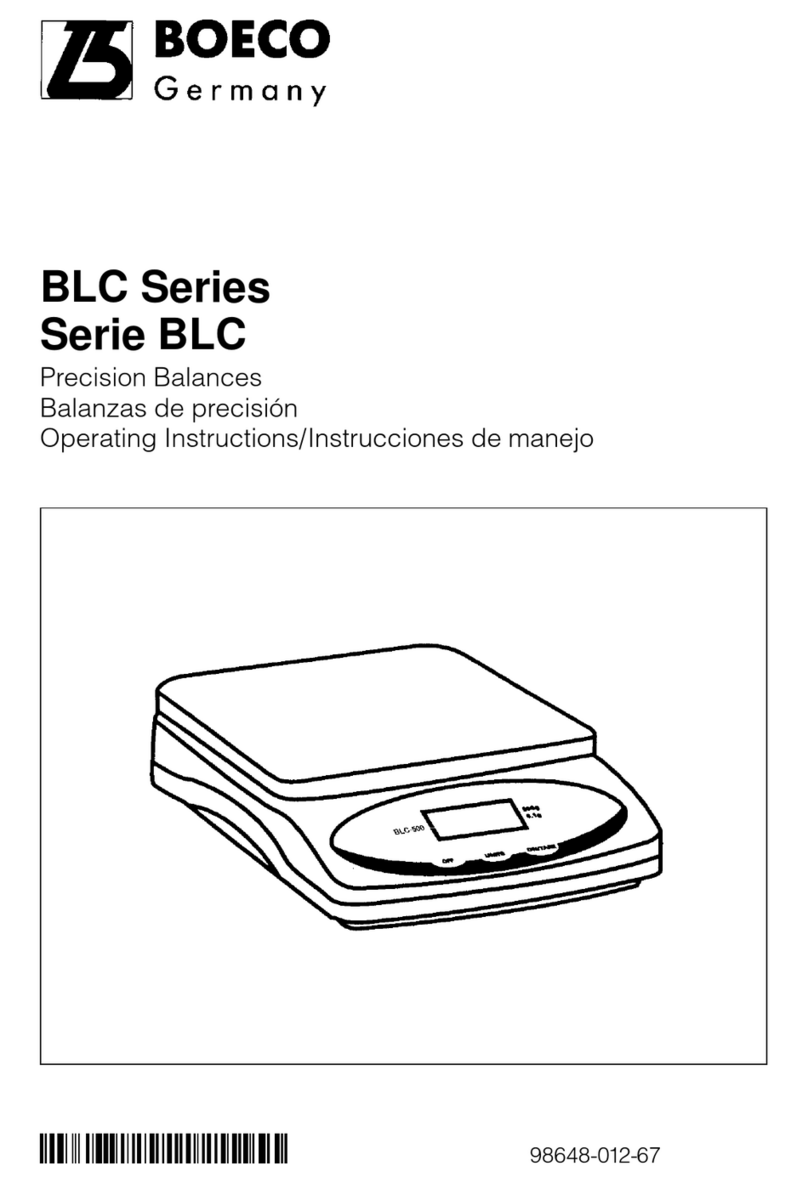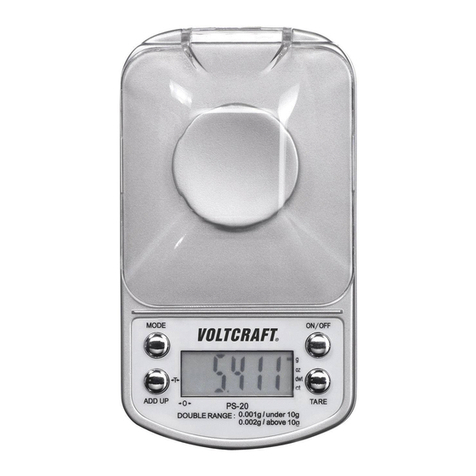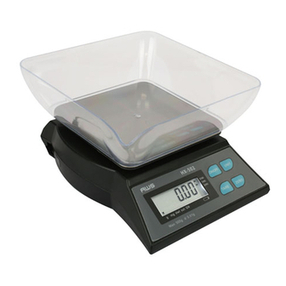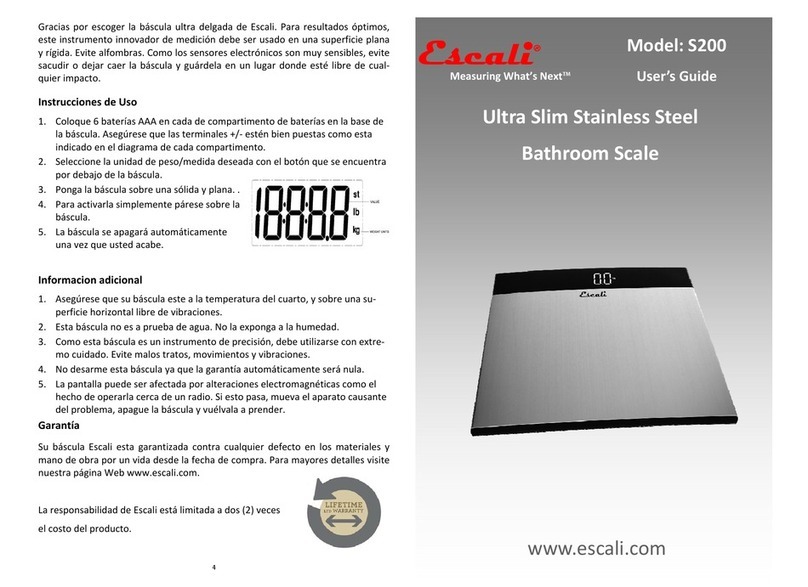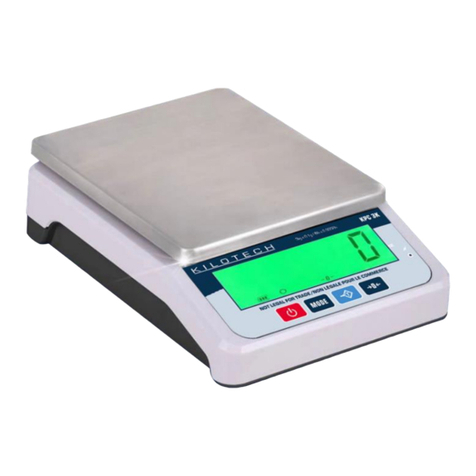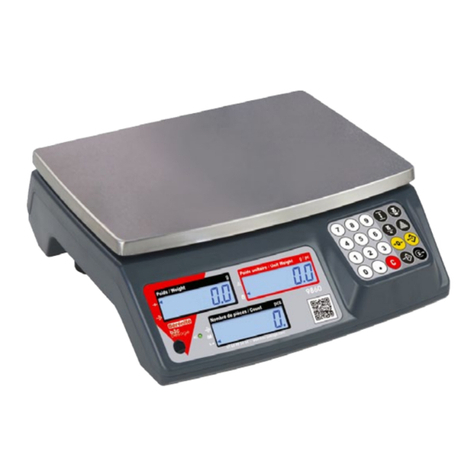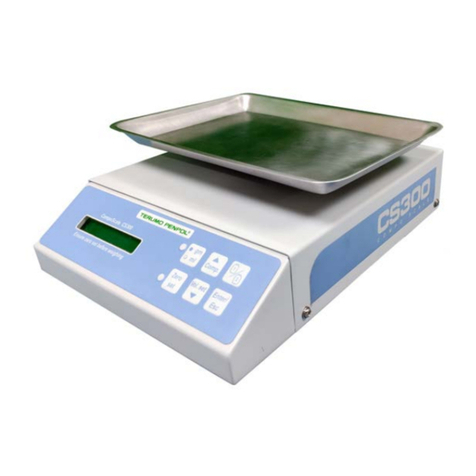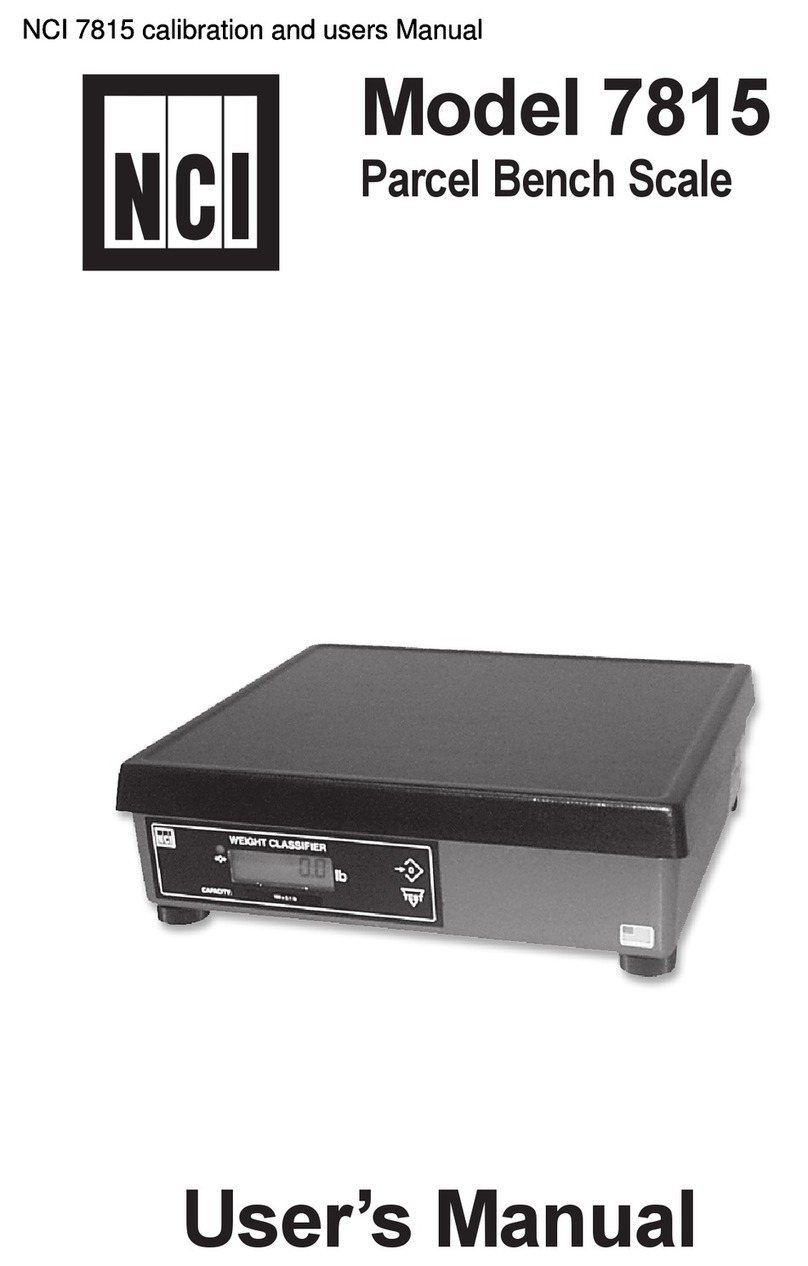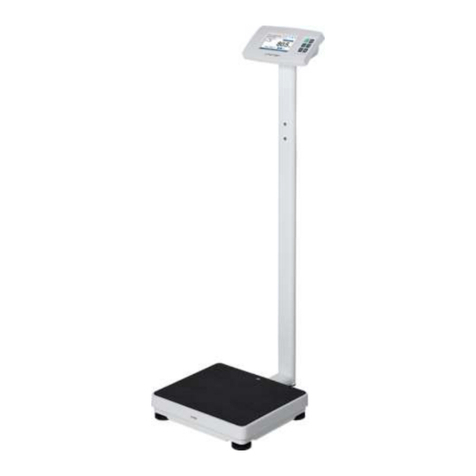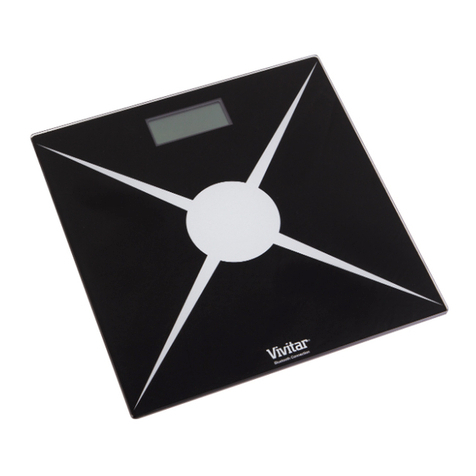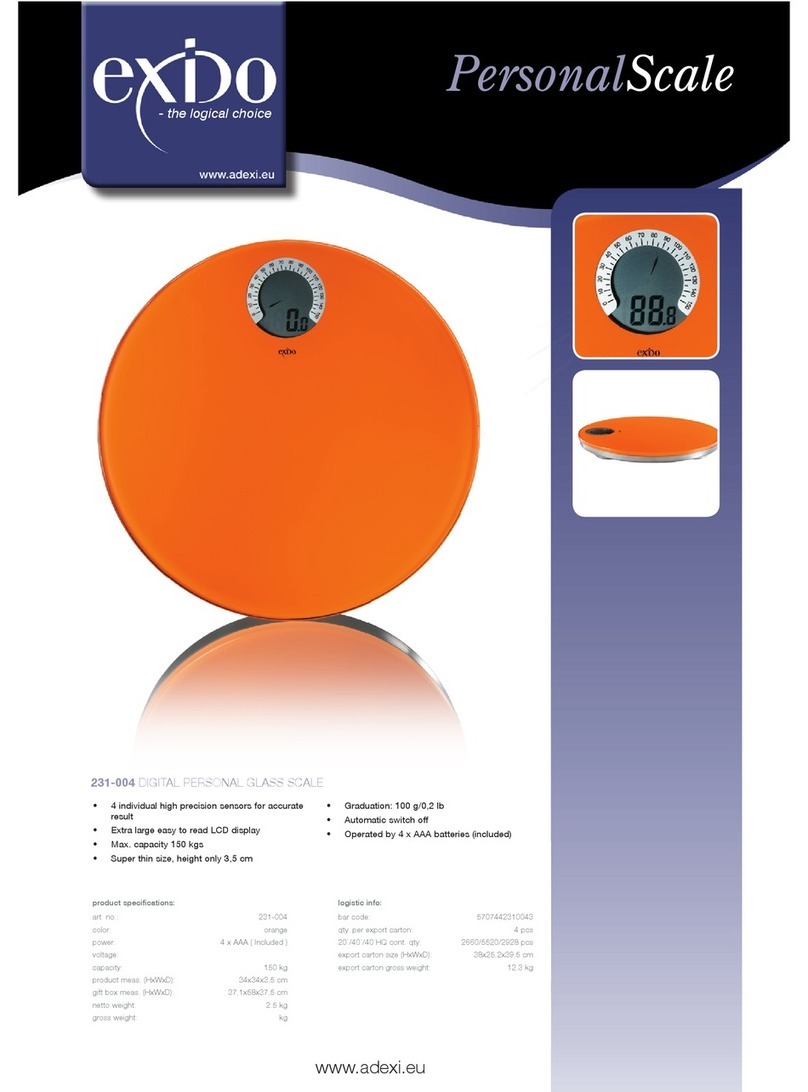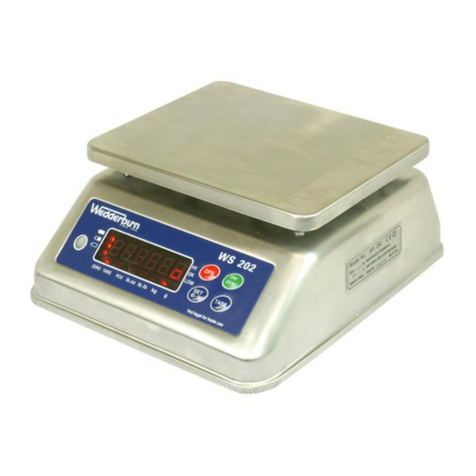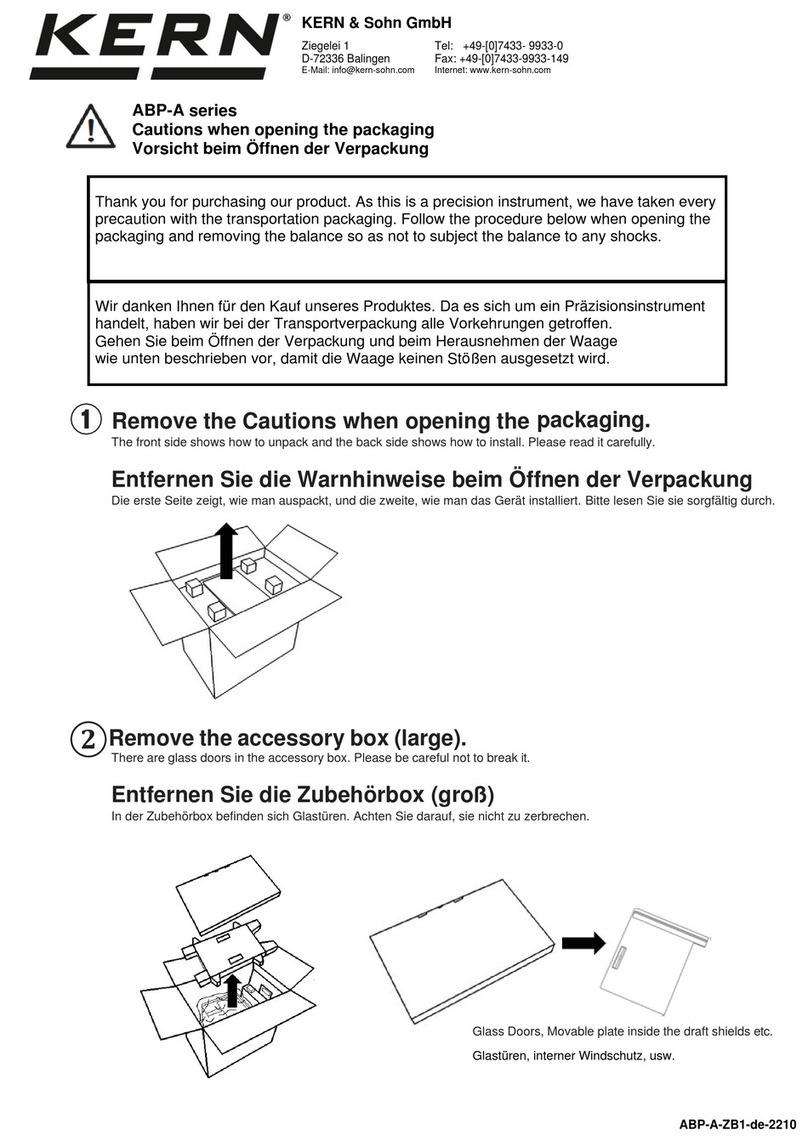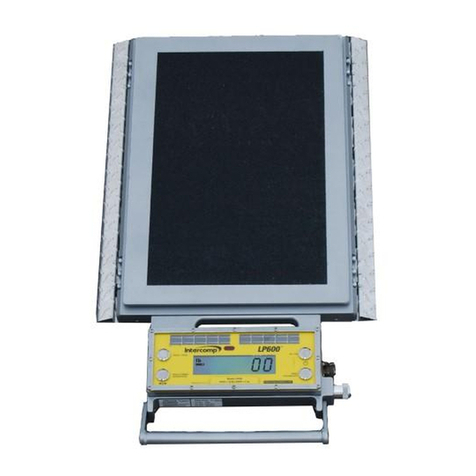Boeco BWL Series User manual

2
JULY 2021

3
PRECAUTIONS
Prior to installation, use or maintenance activities, carefully read this user
manual and follow the provided guidelines.
Prior to the first use, carefully read this user manual. Use the weighing
device only as intended.
Place weighed loads in the centre of the weighing pan.
Load the weighing pan with loads of gross weight which does not exceed
the maximum capacity.
Mind not to leave heavy loads on the weighing pan for l
onger periods
of time.
Protect the indicator against considerable temperature variation, solar and
UV radiation, substances causing chemical reactions.
The C32 scale must not be operated in hazardous areas endangered with
explosion of gases, and in dusty environments.
In case of damage, immediately unplug the device from the mains.
Scales to be decommissioned must be decommissioned in accordance
with valid legal regulations.
Do not let battery discharge in case of prolonged storage of the device
in low temperature.
A worn out battery can be replaced only by the manufacturer or by the
authorized service.
Accumulators do not belong to regular household waste. The European
legislation requires discharged accumulators to be collected and disposed
separately from other communal waste with the aim of being recycled.
Symbols on batteries identify harmful compounds: Pb = lead,
Cd = cadmium, Hg = mercury. Dear user, you are obliged to dispose of the
worn out batteries as regulated.
If the sc
ale is to be operated in conditions that are difficult due to
electrostatics (e.g. printing house, packing centre, etc.), you must connect
it to the earth wire. To enable this, the device features functional earthing
terminal, marked with symbol.

4
CONTENTS
1. INTENDED USE .................................................................................................................................................5
2. WARRANTY CONDITIONS ...............................................................................................................................5
3. MAINTENANCE ACTIVITIES ............................................................................................................................6
3.1. Cleaning ABS Components.........................................................................................................................6
3.2. Cleaning Glass Components.......................................................................................................................7
3.3. Cleaning Stainless Steel Components........................................................................................................7
3.4. Cleaning Powder-Coated Components.......................................................................................................7
3.5. Cleaning Aluminium Components...............................................................................................................8
4. SERVICE AND REPAIR.....................................................................................................................................8
5. RECYCLING.......................................................................................................................................................8
6. MECHANICAL DESIGN.....................................................................................................................................9
6.1. Dimensions..................................................................................................................................................9
6.2. Connectors Arrangement ..........................................................................................................................10
6.3. RS232 Connectors ....................................................................................................................................10
6.4. Inputs / Outputs .........................................................................................................................................10
6.4.1. Technical Specifications.................................................................................................................11
6.4.2. I/O Schematic Diagrams ................................................................................................................11
6.5. Operation panel.........................................................................................................................................12
7. INSTALLATION................................................................................................................................................13
7.1. Unpacking and Installation ........................................................................................................................13
7.2. Under-Pan Weighing .................................................................................................................................13
7.3. Levelling.....................................................................................................................................................14
7.4. Connecting the Scale to the Mains ...........................................................................................................15
7.5. Warm-Up Time ..........................................................................................................................................15
7.6. Battery Charge Status...............................................................................................................................15
7.7. Battery Charge Status Check....................................................................................................................16
8. OPERATING THE MENU.................................................................................................................................16
8.1. Return to the Weighing Mode....................................................................................................................17
9. WEIGHING........................................................................................................................................................17
10. DIAGRAMS OF CONNECTION CABLES.....................................................................................................18
11. TECHNICAL SPECIFICATIONS....................................................................................................................19
12. TROUBLESHOOTING ...................................................................................................................................19
13. ERROR MESSAGES .....................................................................................................................................20

5
1. INTENDED USE
BWL precision scales enable fast and accurate mass measurements under
laboratory and industrial conditions. The devices are equipped with an internal
battery which allows their operation in places where there is no access to the
mains. The BWL series features a stainless steel weighing pan, and a backlit
LCD guaranteeing clear weighing result presentation.
BWL precision scales are equipped with the following interfaces:
2 x RS232, USB type A, and USB type B, wireless communication (option).
The interfaces enable cooperation between the scale and peripheral devices
(e.g. printer, computer, USB flash drive).
This equipment has been tested and found to comply with
the limits for a Class A digital device, pursuant to part 15
of the FCC Rules. These limits are designed to provide
reasonable protection against harmful interference when the
equipment is operated in a commercial environment.
This equipment generates, uses and can radiate radio
frequency energy and, if not installed and used in
accordance with the instruction manual, may cause harmful
interf
erence to radio communications. Operation of this
equipment in a residential area is likely to cause harmful
interference in which case the user will be required
to correct the interference at his own expense.
This equipment has been tested and found to comply with
the limits for a Class A according to standards, listed in
declaration of conformity, required by European regulations
in order to use CE marking. This equipment is not intended
for use in residential environments and may not provide
adequat
e protection to radio reception in such
environments. Class A products may also be utilized in
residential/domestic environments but may cause
interference and require the user to take adequate corrective
measures.
2. WARRANTY CONDITIONS
A. BOECO feels obliged to repair or exchange all elements that appear
to be faulty by production or by construction.
B. Defining defects of unclear origin and means of their elimination can only
be realized with assistance of manufacturer and user representatives.

6
C. BOECO does not bear any responsibility for damage or losses resulting
from unauthorized or inadequate performing of production
or service processes.
D. The warranty does not cover:
•mechanical damage caused by product exploitation other than
intended, damage of thermal and chemical origin, damage caused by
lightning, overvoltage in the power network or other random event,
•inappropriate cleaning habits.
E. Loss of warranty takes place if:
•a repair is carried out outside BOECO authorized service point,
•service claims intrusion into mechanical or electronic construction
by unauthorized people,
•the device does not bear company security stickers.
F. Warranty conditions outline the warranty period for rechargeable
batteries attached to the device for 12 months.
G. For detailed warranty conditions read the warranty certificate.
3. MAINTENANCE ACTIVITIES
In order to ensure safety in the course of cleaning, it is necessary to disconnect
the device from the mains. With this condition met, uninstall the weighing pan
and other detachable components.
Cleaning the weighing pan while still installed may cause
damage of the measuring system.
3.1. Cleaning ABS Components
To clean dry surfaces and avoid smudging, use clean non-colouring cloths
made of cellulose or cotton. You can use a solution of water and detergent
(soap, dishwashing detergent, glass cleaner). Gently rub the cleaned surface
and let it dry. Repeat cleaning process if needed.
In the case of hard to remove contamination, e.g. residues of adhesive, rubber,
resin, polyurethane foam etc., you can use a special cleaning agents based on
a mixture of aliphatic hydrocarbons that do not dissolve plastics. Before using
the cleanser for all surfaces we recommend carrying out tests. Do not use
cleansers containing abrasive substances.

7
3.2. Cleaning Glass Components
Select dissolvent depending on a dirt. Never soak the glass panes in alkaline
solutions since they interact with glass and may cause damage. Do not use
cleansers containing abrasive substances.
For organic dirt use acetone first, next use water or detergent. For other than
organic dirt use diluted acid solutions (soluble salts of hydrochloric or nitric
acid) or base solutions (ammonium or sodium base).
To remove ACIDS use protophilic solvent (sodium carbonate), to remove BASE
use protogenic solvent (mineral acid of various concentration).
In case of heavy contamination use brush and detergent, nevertheless avoid
detergents containing large and hard molecules which could potentially scratch
glass panes.
At the end of the cleaning process rinse the pane using distilled water. Use soft
brush with wooden or plastic handle exclusively in order to avoid risk
of scratches. Do not use wire brush. Rinsing is a necessary cleaning process
stage allowing to remove remaining soap, detergents and other cleansers from
the panes prior their reinstallation. After preliminary cleaning process stage,
rinse the pane using running water first, distilled next.
Avoid drying the panes either using paper towel or forced air circulation since
some fibres, grains or contamination of other type could permeate into the
panes thus causing weighing errors. We do not recommend using driers when
drying measuring glass tools. It is a frequent treatment to leave glass
components on a rack to dry.
3.3. Cleaning Stainless Steel Components
Avoid using cleansers containing any corrosive chemicals, e.g. bleach
(including chlorine). Do not use cleansers containing abrasive substances.
Always remove the dirt using microfiber cloth to avoid damage of protective
coating.
In case of a daily maintenance:
1. Remove the dirt using cloth dipped in warm water.
2. For best results, add a little bit of dishwashing detergent.
3.4. Cleaning Powder-Coated Components
For preliminary cleaning process stage you need running water or wet sponge
featuring large holes, this will help you to remove loose, heavy dirt. Do not use
cleansers containing abrasive substances. Next, using cloth and cleanser-
water solution (soap, dishwashing liquid) gently rub the cleaned surface.

8
Avoid using cleanser without water since it may result with damage of the
cleaned surface, please mind that large amount of water mixed with cleanser
is a must.
3.5. Cleaning Aluminium Components
While cleaning aluminium components use products acid by nature, e.g. spirit
vinegar, lemon. Do not use cleansers containing abrasive substances. Avoid
using hard brush, this may cause scratches.
It is recommended to use microfibre cloth. While polishing the surface use
circular movements. Use clean, dry cloth to make the surface shine.
4. SERVICE AND REPAIR
In case of any sign of damage, it is necessary to disconnect
the device form the mains immediately. The damaged
component must be replaced or repaired by BOECO service
directly.
In case of any problems with correct operation of the scale, contact the closest
manufacturer's service point. In case of defects, deliver the faulty product to the
manufacturer's service point. If the product cannot be delivered to the
manufacturer's service point, call the service and report the defect. Repair
scope and method will be set up.
The user is NOT ALLOWED to carry out any kind of repair
of the device himself/herself. Any attempt of scale
modification, repair etc., by unauthorized persons, will result
with loss of validity of manufacturer-issued certificates,
declarations and warranty.
5. RECYCLING
BWL scales must be recycled, they are not to be treated as a regular
household waste. Scales to be decommissioned must be decommissioned
in accordance with valid legal regulations.

9
6. MECHANICAL DESIGN
6.1. Dimensions
BWLprecision scale

10
6.2. Connectors Arrangement
Connectors view
1- power supply socket 12 VDC
2- RS232 (1) connector
3- RS232 (2) connector
4- USB A "host"
5- USB B "device"
6.3. RS232 Connectors
RS232 (1) connector DB9/M (male)
Pin2 – RxD
Pin3 – TxD
Pin4 – 5 VDC
Pin5 – GND
RS232 (2) connector DSUB15/F (female)
Pin8 - TxD2
Pin9 - 5 VDC
Pin10 - GNDRS
Pin13 - RxD2
6.4. Inputs / Outputs
Standard BWL scale is equipped with 4 optoisolated inputs and 4
semiconductor outputs (solid-state relays). The signals are sent via DSUB15/F
connector.

11
IN/OUT connector DSUB15/F (female)
Pin1 – GNDWE
Pin2 - OUT1
Pin3 - OUT2
Pin4 – COMM
Pin6 - IN4
Pin7 - IN3
Pin11 - IN2
Pin12 - IN1
Pin14 - OUT4
Pin15 - OUT3
6.4.1. Technical Specifications
Output parameters
Output quantity 4
Output type Solid-state relay
Cable cross-section 0.14 - 0.5 mm2
Maximum output current 0.5 A DC
Maximum output voltage 30 VDC
Input parameters
Input quantity 4
Input type Optoisolated
Cable cross-section 0.14 - 0.5 mm2
Input voltage range 5÷24VDC
6.4.2. I/O Schematic Diagrams
4 inputs 4 outputs

12
6.5. Operation panel
Operation panel of BWL precision scale
Keys:
Press to switch the weighing device on/off –
hold the key for about 1
second.
Function key, press to change the working mode.
Press to send the weighing result to a printer or computer.
Press to zero the scale.
Press to tare the scale.
Upon pressing +
keys combination, functions
of given keys change. Detailed information concerning use
of + keys combination is to be found further down
this manual.

13
7. INSTALLATION
7.1. Unpacking and Installation
•Unpack the device and place it on a flat and even surface. Keep it far
away from any sources of heat.
•Install the weighing pan, follow the below figures:
BWL precision scale
7.2. Under-Pan Weighing
The BWL scales enable weighing loads below scale (so called under-pan
weighing). This is an alternative for loads of non-standard dimensions and
shapes, and for loads generating magnetic field.

14
Preparing the scale for the under-pan weighing:
1.
Unpack the scale, assembly it
following section 7.1
of this
user manual. -
2. Put the scale right side down.
3. Remove the hole plug.
4.
Mount the hook and put
the scale bottom side down.
7.3. Levelling
To level the weighing instrument turn its feet. Keep turning the feet until the air
bubble takes central position:

15
7.4. Connecting the Scale to the Mains
The weighing device can be connected to the mains only with a power supply
that comes standard with the particular model. Nominal voltage of the power
supply (specified on the power supply data plate) has to be compatible with the
mains nominal voltage.
Procedure:
•Connect the power supply to the mains. Plug it to the power supply socket
(back side of the scale housing).
•Press key. The key is also used to switch the scale on/off.
•Display test proceeds (all symbols are backlit for a moment), program
name and number is displayed first, ZERO indication with reading unit
next (displayed reading unit is conditioned by scale type).
•In case the weighing result is not zero after indication stabilisation, press
key.
7.5. Warm-Up Time
•For correct scale operation, the workroom temperature must range
between +15°C ÷+30°C.
•It takes 30 minutes for the device to warm up.
•During the thermal stabilization, the indications on the screen can change.
•If you want to carry out adjustment operation, make sure that your device
is thermally stable.
•Temperature and humidity variations during operation may cause
indication errors. To remove the indication errors perform user adjustment.
7.6. Battery Charge Status
The scale of standard design is equipped with an internal battery. Battery state
is signalled by pictogram, the pictogram is displayed in the top bar of the
display.

16
pictogram display mode Meaning
No pictogram Battery charged. Regular scale operation.
Pictogram displayed continuously Too low battery charge (the scale is about to shut
down). Charge the battery immediately.
Blinking pictogram, blink frequency:
ca. 1 s Battery charge in progress. The device is connected
to the power supply charging the battery.
Blinking pictogram, blink frequency:
ca. 0.5 s Battery error. Battery is damaged.
7.7. Battery Charge Status Check
•Press and keys combination.
•Depending on the battery state, a respective status is displayed on the
screen for 2s:
80% Battery power supply. Battery power given in %.
CHArGE Battery charge in progress. The device is connected to the power supply
charging the battery.
-Err5- Battery error. Battery is damaged.
•Next, the home screen is displayed automatically.
8. OPERATING THE MENU
In order to navigate the program menu use the operation panel.
+
Press to enter the main menu.
+
Press to enter tare manually.
Press to enter tare from tare database.
Press to change value by 1 digit up.
Press to scroll the menu up.
+
Press to check battery/accumulator state.
+
Press to view date/time.
Press to scroll the menu down.
Press to change current parameter value.
Press to enter given submenu.
Press to modify given parameter.

17
Press to confirm modification.
Press to exit, function remains unmodified.
Press to move one menu level up.
8.1. Return to the Weighing Mode
Introduced menu modifications are automatically saved to scale memory upon
return to the home screen. To return to the home screen press key
repeatedly.
9. WEIGHING
Load the weighing pan. Read the result when stability marker is displayed.
To assure long-term operation and correct mass measurements, follow
the rules presented below:
Load the weighing pan steadily
avoiding mechanical shocks.
Place weighed loads centrally on the
weighing pan (eccentricity errors are
specified by EN 45501 standard, point
3.6.2.).
Do not apply concentrated force (total
load in one point).
Avoid side loading, in particular side
shocks.

18
10. DIAGRAMS OF CONNECTION CABLES
scale – computer cable
scale - printer cable (EPSON)
I/O cable

19
11. TECHNICAL SPECIFICATIONS
For technical specifications of respective scales go to BOECO website
www.boeco.com
12. TROUBLESHOOTING
Problem Cause Solution
Scale start-up fail.
Power supply disconnected. Connect the power supply to the scale.
Battery discharged.
Connect the power supply to the mains,
charge the battery.
No battery (not installed or
installed incorrectly).
Check if the battery is installed correctly
(polarization).
The scale switches
off automatically.
<7.4.t1> parameter set to
value enforcing scale shut-
down after particular time
interval.
Go to <P7.Othr> menu, set <7.4.t1>
parameter to 'nonE' value.
During the start-up,
message 'LH' is
displayed.
Weighing pan loaded during
the start-up. Unload the weighing pan. Zero indication
is displayed.
Communication with
the computer not
established.
Incorrect computer port set in
parameter <5.1.1.Prt>.
Enter < P5.ducE / 5.1.PC> submenu and
set correct <5.1.1.Prt> parameter value.
Incorrect transmission
parameters for the selected
computer port.
Enter <P4.Conn> menu and set correct
transmission parameters for the selected
computer port.
Incorrect
printout frequency
for continuous transmission.
Enter < P5.ducE / 5.1.PC> submenu and
set correct <5.1.3.Int> parameter value.
No prin
tout on a
scale-connected
printer.
Incorrect printer port set in
<5.2.1.Prt> parameter. Enter < P5.ducE / 5.2.Prtr> submenu and
set correct <5.2.1.Prt> parameter value.
Incorrect transmission
parameters for the selected
printer port.
Enter <P4.Conn> menu and set correct
transmission parameters for the selected
printer port.
No variable declared in
weighing printout project.
Enter <P6.Prnt / 6.2.GLP> submenu and
declare variables that are to be printed.
Communication with
the additional display
not established..
Incorrect additional display
port set in <5.3.1.Prt>
parameter.
Enter < P5.ducE / 5.3.AdSP> submenu
and set correct <5.3.1.Prt> parameter
value.
Incorrect transmission
parameters for the selected
computer port.
Enter <P4.Conn> menu and set correct
transmission parameters for the selected
additional display port.
Displayed mass unit
does not comply with
the scale data plate.
Changed scale start unit in
<9.1.UnSt> parameter.
Enter <P9.Unit / 9.1.UnSt> submenu and
set unit complying with the scale data
plate.
Changed custom unit in
<9.2.Unin> parameter.
Enter <P9.Unit / 9.2.Unin> submenu and
set unit complying with the scale data
plate.

20
13. ERROR MESSAGES
- E r r 2 -
Value beyond zero range.
- E r r 3 - Value beyond tare range.
- E r r 4 - Adjustment weight or start mass out of range (±1% for adjustment weight, ±10 for
start mass).
- E r r 5 -
Battery error. Battery is damaged.
- E r r 8 -
Time of the following operations exceeded: taring, zeroing, start mass
determining, adjustment process.
- n u l l - Zero value from converter.
- F U L L - Weighing range exceeded.
- L H -
Start mass error, indication out of range (
±
10% of start mass).
- H i -
Display range of total mass on scale display exceeded in 'Totalizing' mode.
- u L o - Too low battery charge. The scale is about to shut down.
- E r r L o - - Determined mass of single part in 'Parts counting' mode too small.
- Value of 'Min' threshold is greater than value of 'Max' threshold in '+/- control'
mode.
- E r r H i -
- Entered value of single part greater than maximum capacity in 'Parts counting'
working mode.
- Entered value of 'Max' threshold greater than maximum capacity in '+/- control'
mode.
- Entered reference mass greater than maximum capacity in 'Percent weighing'
mode.
This manual suits for next models
3
Table of contents
Other Boeco Scale manuals


